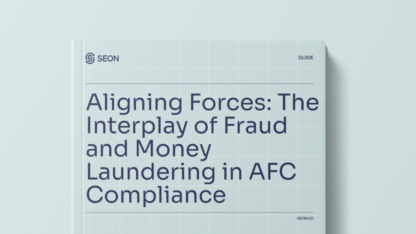The market value of companies like Square, Visa, Payal and Mastercard in the US is now estimated to be worth $1.07 Trillion, eclipsing the $900B of the big six traditional banks JPMorgan, Bank of America, Wells Fargo, Citigroup, Morgan Stanley and Goldman Sachs. Redrawing the lines of the financial industry, however, does not happen overnight, nor without disruption.
Following the 2008 credit crisis, an increase in regulations, heavy non-compliance fines and penalties created the perfect momentum to punish legacy banking institutions, and foster innovation with the young newcomers.
In the downloadable guide about the state of fintech, we’ll examine the disruption caused by these startups, adjustments made by large financial institutions, and the challenges faced by both types of organizations – with a specific focus on the increasing burden of online fraud.
What to Find in Our Guide: A Breakdown of the Fintech Boom
We explore the market forces, changes in consumer habits, and technological advances that are leading to our current fintech boom.
We’ll look at other factors such as:
- The acceleration of the mobile economy: how smartphone adoption is enabling fintechs to gain traction worldwide.
- The increase in payment channels: consumers have access to an increasing number of payment options. See why businesses must offer a complex web of payment solutions and how fintechs help.
- Changing customer standards: friction is becoming the battleground where users are winning and losing. How are challenger banks creating new expectations about what a financial service should be?
We’ll also look at technological features such as fintech’s ability to slice and dice data, and the pros and cons of the model versus traditional FIs and brick and mortar retail banking.
Key Fintech Trends
A large chapter of our state of fintech fraud guide focuses on future predictions and trends for the fintech vertical. We examine several potential scenarios, where fintechs turn from banking disruptors to partners, and how regulations like Europe’s PSD2 compliance could pave the way for a new wave of services, products and features.
We also look at how modern tech will play a factor in things to come, including:
- Blockchain technology: While blockchain technology has not yet brought an end to the lack of transparency in the industry, we will begin to see the first tokenised commercial financial projects. Mastercard, for instance, already has several patents for the fractional reserve management of blockchain
- IoT (Internet of Things): By integrating IoT into FinTech, banks and other financial institutions can enhance data protection and customer service, while wearables can become a powerful branding tool. Certain wearable devices such as smartwatches will also facilitate digital payments.
- Voice banking: Ally Bank, Mercantile Bank of Michigan, and Capital One already offer voice banking features. While the tasks you can currently perform with voice banking are limited it isn’t too far-fetched to believe many banking tasks will be done by voice in the near future, such as transferring money and applying for mortgages.
- RPA software: Robotic Process Automation (RPA) software will be widely used in 75% of financial services institutions by 2020, automating repetitive human processes by utilising the exact same application interface a human would, and eliminating built-in human inefficiencies.
However, the deployment of these new technologies is not without challenges, especially in the context of security and cybercrime – which we explore in our chapters dedicated to digital threats.
The Widening Range of Fintech Threats – Cybersecurity and Fraud
The second section of our guide takes a deep dive into the challenges, fintechs must face when it comes to fraud and security. We’ll look at DDoS attacks, advanced phishing techniques, social engineering, and the constant threat of data breaches.
We’ll also look at why online fraud becomes costlier for fintechs, especially when looking at problems such as ATO attacks, chargeback disputes costs, affiliate marketing fraud, and the increasing regulatory fines.
Fraud Fighting Techniques for Fintechs
Finally, we will offer concrete tips and tricks on how to stop fraud at your fintech. This begins with a breakdown of our own experience getting an online loan using false IDs. Here are the 7 steps we had to take:
- Acquiring stolen data: the first step was to acquire cryptocurrencies and purchase something called a Fullz – a package consisting of an address, date of birth, and social security number.
- Faking credit scores: of course, loan companies try to protect themselves from scams by deploying credit scoring systems. Unfortunately, fraudsters have a way around it. We simply purchased background and credit information with pre-existing high credit scores. Fraudsters often pay with a stolen credit card to avoid unnecessary expenses.
- Bypassing IP checks: another common way to flag fraudsters is to block suspicious IP addresses. Once again, this is easily fooled simply by purchasing a validated IP address, for instance from a residential UK address.
- The bank drop: loan companies will pay directly into a bank account. Fraudsters can simply purchase one from an illegal marketplace. It will sometimes provide a credit or debit card along with the required IBAN number.
- Phone verification: most online companies will implement 2FA authentication these days, which requires a phone number. Fraudsters can easily download apps from the App or Play store to generate numbers on a “burner” phone – one that is designed not to leave a trace.
- The loan application: at that stage, fraudsters have already found everything they need. But loan companies sometimes require extra document verification proof showing at least basic information. Since it’s unlikely fraudsters already have the exact paperwork they need, they can simply use an online service that photoshops the right paperwork for them.
- Cashing out: finally, fraudsters will need to wire the loan to the bank drop. Cashing the money out from the bank drop is really nowadays. This usually means sending it to a cryptocurrency exchange, where they can buy bitcoins or other currencies, which can be used to continue purchasing goods or more fraud tools.
Our own experience highlights how easy it was to fool a fintech’s defense, and we further break down the exact techniques and technology you need to set up in order to secure yours.
This includes examples of email profiling, social media lookups, device fingerprinting and more. We’ll also look at compliance with regulations such as the GDPR, and compare models such as micro fees vs chargeback guarantee.
Protect Your Fintech From Fraud Now
Ready to scale up your operations without suffering losses from chargebacks, AML and KYC fines, and transaction fraud?
Download our complete guide on the state of fintech and fraud today to see how the latest anti-fraud technology can help you gain traction and onboard more users safely.
You might be interested in:
Alternative Credit Scoring: What is it & how it works?
Learn more about:
Data Enrichment | Browser Fingerprinting | Device Fingerprinting | Fraud Detection API








